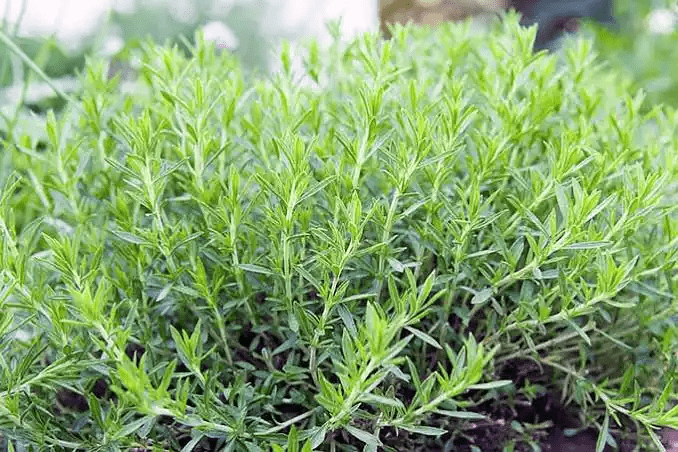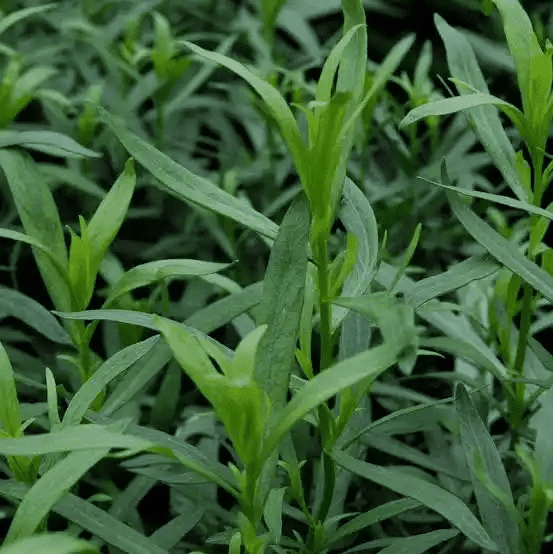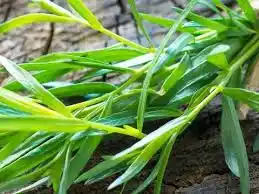Tarragon, scientifically known as Artemisia dracunculus, is a perennial herb that belongs to the Asteraceae family. Revered for its distinctive flavor and aromatic qualities, tarragon has found its place in the culinary world, enhancing the taste of various dishes.
This herb is native to Eurasia, particularly the regions of Siberia and Western Asia, and has been cultivated for centuries for both culinary and medicinal purposes.
Known for its narrow, lance-shaped leaves that are dark green in color, tarragon is characterized by its pleasant, anise-like scent. The leaves are typically smooth and glossy, with a slightly serrated edge.
The plant itself can reach a height of up to two feet and features small, greenish-yellow flowers that bloom in clusters during the summer months.
Tarragon’s aesthetic appeal, combined with its culinary value, makes it a popular choice for herb gardens and kitchen windowsills.
Culinary enthusiasts value tarragon for its unique flavor profile, which is often described as a blend of sweet licorice and subtle peppery undertones.
The herb is a key ingredient in French cuisine, particularly in the classic herb blend fines herbes. Tarragon pairs exceptionally well with fish, chicken, eggs, and a variety of vegetables.
It is also a crucial component in the renowned Béarnaise sauce, adding a distinct and savory element to this culinary masterpiece.
Aside from its culinary applications, tarragon has a rich history of medicinal use. Traditionally, it has been employed to alleviate digestive issues, stimulate appetite, and provide relief from mild pain.
Some cultures have even used tarragon as a remedy for insomnia and anxiety due to its mild sedative properties.
However, it’s important to note that while tarragon has been used in traditional medicine, consulting with a healthcare professional is always recommended before using it for therapeutic purposes.
The cultivation of tarragon is relatively straightforward. It thrives in well-drained soil and requires ample sunlight. The herb is often propagated through cuttings or by dividing existing plants.
Tarragon can be grown in both garden beds and containers, making it accessible to a wide range of gardening enthusiasts. Regular pruning helps maintain the plant’s shape and encourages the growth of fresh, flavorful leaves.
In addition to its culinary and medicinal attributes, tarragon has made its mark in the realm of folklore and symbolism. In various cultures, it has been associated with protection and was believed to ward off evil spirits.
The herb’s name is derived from the Latin word “dracunculus,” meaning “little dragon,” possibly alluding to the twisted shape of its roots.
Tarragon, with its alluring aroma, distinctive flavor, and historical significance, stands as a versatile herb with a multitude of uses.
Whether gracing the plates of gourmet chefs or finding a place in the gardens of home cooks, tarragon continues to captivate with its charm and contribute to the rich tapestry of culinary and botanical traditions.
The Botanical Description of Tarragon
1. Botanical Identity: Scientifically known as Artemisia dracunculus, this perennial herb belongs to the Asteraceae family, recognized for its aromatic leaves that play a vital role in culinary and medicinal applications.
2. Foliage and Growth Habit: Featuring narrow, lance-shaped leaves with a distinct anise-like fragrance, tarragon’s leaves are glossy and dark green, creating a visually appealing plant with an upright growth habit that can reach around two feet.
3. Flowers and Inflorescence: Tarragon produces small, greenish-yellow flowers arranged in loose clusters. While not the primary focus, the inflorescence adds a delicate aesthetic to the herb.
4. Root System: Tarragon develops a rhizomatous root system, aiding in its perennial nature by storing energy and nutrients, supporting growth and survival during adverse conditions.
The Geographic Distribution of Tarragon
1. Origin and Native Habitat: Believed to have originated in Siberia and parts of Central Asia, tarragon’s native habitat includes regions with well-drained soils and a temperate climate.
2. Global Cultivation: While native to certain areas, this herb has become widely cultivated globally. Thriving in various climates, it is particularly suited to temperate regions, where it can be grown both outdoors and in controlled environments.
3. Culinary Regions: A staple in many culinary traditions, tarragon is commonly used in French cuisine for fines herbes and in Mediterranean and Russian cuisines, showcasing its versatility.
4. Garden and Pot Cultivation: A popular choice for herb gardens and container gardening, its adaptability to pot cultivation allows individuals in diverse geographic locations to enjoy the herb’s flavors and aromatic qualities.
The Chemical Composition of Tarragon
1. Essential Oils: Rich in essential oils, with estragole (methyl chavicol) as a dominant component, contributing to the herb’s characteristic anise-like aroma and flavor.
2. Polyphenols and Antioxidants: Containing various polyphenols, including flavonoids and phenolic acids, tarragon acts as an antioxidant, playing a role in neutralizing free radicals in the body.
3. Vitamins and Minerals: A source of essential vitamins such as A and C, along with minerals like calcium, magnesium, and iron, tarragon contributes to its nutritional value.
4. Medicinal Compounds: Beyond culinary uses, tarragon contains compounds with potential medicinal benefits, suggesting anti-inflammatory and antimicrobial properties, though more research is needed to understand fully.
In summary, the botanical description, geographic distribution, and chemical composition underscore its significance as both a culinary herb and a potential source of health benefits. Whether grown in gardens, used in regional cuisines, or explored for its chemical constituents, tarragon continues to captivate enthusiasts worldwide.
Read Also: Career Opportunities in Agribusiness
The Medicinal Health Benefits Of Tarragon (Artemisia dracunculus)

1. Digestive Aid: Recognized for its digestive properties, tarragon promotes the production of digestive fluids, easing discomfort associated with indigestion.
2. Anti-Inflammatory Effects: Compounds in this herb exhibit anti-inflammatory properties, potentially aiding in the management of inflammatory conditions.
3. Appetite Stimulation: Traditionally used to stimulate appetite, tarragon is beneficial for individuals with reduced appetite or those recovering from illnesses.
4. Pain Relief: This herb may have mild analgesic properties, providing relief from certain types of pain when used responsibly.
5. Respiratory Support: Tarragon offers respiratory benefits, helping to alleviate symptoms of respiratory conditions and promoting overall lung health.
6. Antioxidant Protection: Rich in antioxidants, it helps combat oxidative stress in the body, supporting overall health and potentially reducing the risk of chronic diseases.
7. Blood Sugar Regulation: Some studies suggest that tarragon may contribute to blood sugar regulation, making it a potential aid for individuals with diabetes.
8. Sleep Aid: It is believed to have mild sedative properties, which may help individuals relax and improve sleep quality.
9. Menstrual Symptom Relief: For some individuals, tarragon may offer relief from menstrual symptoms such as cramps and discomfort.
10. Anti-Bacterial Action: Compounds in this herb may exhibit antibacterial effects, potentially assisting the body in fighting off certain bacterial infections.
11. Stress Reduction: Tarragon’s calming properties may contribute to stress reduction, helping individuals manage everyday stressors more effectively.
12. Cardiovascular Support: Some studies suggest that it may have cardiovascular benefits, including potential effects on blood pressure and cholesterol levels.
13. Joint Health: Its anti-inflammatory properties may extend to joint health, offering relief for individuals with inflammatory joint conditions.
14. Skin Health: Applied topically, tarragon may contribute to skin health, potentially soothing irritations and promoting a healthy complexion.
15. Immune System Boost: Regular consumption of this herb may support the immune system, helping the body defend against infections and illnesses.
Methods of Usage to Achieve the Provided Health Benefits Of Tarragon
1. Culinary Use: Incorporating fresh or dried tarragon into meals is a common method. It adds flavor to dishes while providing potential health benefits.
2. Tarragon Tea: Brewing tea by steeping fresh or dried leaves in hot water is a popular way to enjoy its medicinal properties.
3. Tinctures and Extracts: Tinctures or extracts offer a concentrated form of its beneficial compounds. These can be added to beverages or taken directly.
4. Aromatherapy: Inhaling the aroma of essential oil through aromatherapy may provide relaxation and stress relief.
5. Topical Applications: Applying infused oils or extracts topically can be beneficial for skin health and localized pain relief.
6. Culinary Infusions: Infusing into oils or vinegars adds flavor and potential health benefits to a variety of dishes.
7. Herbal Combinations: Combining with other complementary herbs in teas or infusions may enhance its overall effectiveness.
8. Dietary Supplements: Supplements, available in various forms, offer a convenient way to incorporate its health benefits into a daily routine.
Side Effects Of Using Tarragon Medicinal Plant
1. Allergic Reactions: Some individuals may experience allergic reactions to it, especially those sensitive to plants in the Asteraceae family.
2. Pregnancy and Breastfeeding: Limited information is available, so pregnant or breastfeeding individuals should consult healthcare professionals before using it medicinally.
3. Blood Clotting: This herb may have mild blood-thinning effects, so individuals on blood-thinning medications should use it cautiously and under medical supervision.
4. Potential Drug Interactions: It may interact with certain medications, particularly those affecting blood sugar levels or blood pressure. Consultation with healthcare professionals is advised.
5. Skin Irritation: Direct contact with oil or extracts may cause skin irritation in some individuals. A patch test is recommended.
6. Stomach Discomfort: Excessive consumption may lead to stomach discomfort in some individuals. Moderation is key.
7. Photosensitivity: Some people may experience photosensitivity after applying oil topically. Sun protection is advisable.
8. Potential Diuretic Effect: It may have a mild diuretic effect, and individuals with kidney issues should monitor their intake.
While tarragon offers a range of potential health benefits, it is essential to use it responsibly and be aware of individual sensitivities. Consulting with healthcare professionals before incorporating it into a medicinal regimen is advisable, especially for those with pre-existing health conditions or taking medications.
Read Also: The Different Properties of Fresh Meat
The Scientific Research and Studies of Tarragon

1. Nutritional Composition: Numerous scientific studies explore the nutritional profile of tarragon, delving into its macro and micronutrient content, highlighting its potential as a valuable dietary component.
2. Medicinal Properties: Research investigates the medicinal aspects of tarragon, focusing on its anti-inflammatory, antioxidant, and potential anti-cancer effects, contributing to the understanding of its therapeutic value.
3. Impact on Chronic Diseases: Scientific studies explore the plant’s impact on chronic diseases such as diabetes and cardiovascular conditions, shedding light on its role in managing and preventing these health issues.
4. Cultivation Techniques: Agricultural studies looked into optimizing tarragon cultivation techniques, aiming to enhance yield, quality, and resistance to pests and diseases.
The Safety Precautions and Recommendations In Using Tarragon Medicinal Plant
1. Allergic Reactions: Prioritize patch tests, especially for topical applications, to identify and avoid potential allergic reactions.
2. Oxalate Sensitivity: Individuals prone to kidney stones or with oxalate sensitivity should moderate consumption, as it contains oxalates that may contribute to stone formation.
3. Moderation in Consumption: Exercise moderation in consumption, especially for individuals with underlying health conditions, to prevent potential adverse effects.
4. Consultation with Healthcare Professionals: Seek guidance from healthcare professionals, particularly for pregnant or breastfeeding individuals and those with existing health conditions, to ensure safe usage.
5. Skin Contact Precautions: When handling the plant, take precautions to avoid direct skin contact, as the latex can cause irritation in sensitive individuals.
6. Blood Sugar Monitoring: Individuals with diabetes should monitor their blood sugar levels when incorporating it into their diet, as it may influence glucose levels.
7. Potential Drug Interactions: Be cautious about potential interactions with medications, and consult with healthcare professionals if you are on a medication regimen.
FAQs About Tarragon Medicinal Plant
1. Is it safe for regular consumption?
Yes, it is safe for regular consumption when incorporated into a balanced diet. However, individuals with specific health conditions should consult with healthcare professionals.
2. Can it be used topically for skin issues?
Yes, extracts can be used topically for wound healing and certain skin conditions. Perform a patch test to check for any allergic reactions.
3. Are there any side effects associated with consumption?
Excessive consumption may lead to gastrointestinal discomfort and, in sensitive individuals, allergic reactions or skin irritation.
4. Can pregnant or breastfeeding individuals use it medicinally?
Limited information is available, and it is advisable for pregnant or breastfeeding individuals to consult with healthcare professionals before using it medicinally.
5. Does it interact with medications?
It may interact with certain medications, so it’s crucial to consult with healthcare professionals, especially if you are on medication regimens.
6. How can it be safely incorporated into the diet?
It can be safely incorporated by cooking it through methods like boiling, baking, or as part of various dishes. Moderation is key.
7. Does it have any impact on blood sugar levels?
Individuals with diabetes should monitor their blood sugar levels when consuming it, as it may affect glucose levels.
8. Can it be grown at home?
Yes, it can be grown at home with proper care. Understanding its cultivation requirements is essential for a successful harvest.
9. Is it suitable for individuals with kidney stones?
Individuals prone to kidney stones should moderate their intake due to its oxalate content, which may contribute to stone formation.
10. How can allergic reactions be avoided?
Conducting patch tests before using it topically can help identify and avoid potential allergic reactions.
11. Are there specific varieties with distinct benefits?
Various varieties exist, each with unique flavors and textures. While nutritional content may vary slightly, all varieties offer health benefits.
12. Can it be included in a weight-loss diet?
Yes, it can be part of a balanced weight-loss diet when consumed in moderation, thanks to its nutritional profile and fiber content.
13. Can it be used as a natural remedy for stress?
Compounds in it may have calming effects, contributing to stress reduction. However, it should not replace professional stress management strategies.
14. Is it suitable for individuals with heart conditions?
Its potassium content supports heart health, but individuals with specific heart conditions should consult with healthcare professionals regarding its consumption.
15. Can it be consumed raw?
While it is often cooked before consumption, some people enjoy it raw in certain dishes. However, cooking is recommended to neutralize potentially harmful compounds.
16. How can it be stored to maintain freshness?
Store it in a cool, dark place with good ventilation, away from direct sunlight. This helps prevent sprouting and extends its freshness.
17. Are there any cultural practices associated with its consumption?
It holds cultural significance in various societies. Understanding traditional recipes and practices enhances the culinary and cultural experience of its consumption.
In conclusion, these FAQs provide valuable information for individuals considering the medicinal use of this plant, addressing safety, consumption methods, and potential side effects. Always consult with healthcare professionals for personalized guidance.
Read Also: 31 Healing Powers of Bitterleaf (Vernonia Amygdalina)

